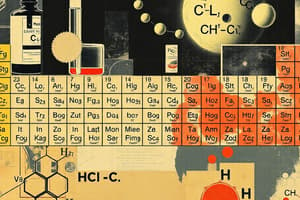Podcast
Questions and Answers
What does a balanced chemical equation represent?
What does a balanced chemical equation represent?
- The reaction will always proceed to completion.
- It indicates the formation of new compounds only.
- The total mass of reactants is greater than the total mass of products.
- The number of atoms of each element is equal on both sides of the equation. (correct)
Which of the following best describes the arrangement of elements in the periodic table?
Which of the following best describes the arrangement of elements in the periodic table?
- Elements are grouped solely by their density and color.
- Elements are arranged randomly without any specific order.
- Elements are listed only by their atomic mass, disregarding other characteristics.
- Elements are organized based on their atomic number and similar chemical properties. (correct)
What is a compound?
What is a compound?
- A type of element that cannot be broken down into simpler substances.
- A substance formed when two or more elements chemically bond in fixed proportions. (correct)
- A substance that can only exist in a gaseous state.
- A substance formed when two or more elements are physically combined.
What is the role of subatomic particles in determining an atom's identity?
What is the role of subatomic particles in determining an atom's identity?
In a chemical reaction, which statement is accurate regarding reactants and products?
In a chemical reaction, which statement is accurate regarding reactants and products?
Flashcards
Periodic Table
Periodic Table
A table that organizes all known elements based on their properties.
Chemical Reaction
Chemical Reaction
A process where substances rearrange to form new substances.
Chemical Equation
Chemical Equation
A shorthand representation of a chemical reaction.
Balancing Equations
Balancing Equations
Signup and view all the flashcards
Atom
Atom
Signup and view all the flashcards
Study Notes
Balanced Chemical Equations
- A balanced chemical equation represents a chemical reaction where the number of atoms for each element on the reactants' side (left) equals the number of atoms for that element on the products' side (right).
- This principle adheres to the Law of Conservation of Mass, which states that matter cannot be created or destroyed in a chemical reaction.
Arrangement of Elements in the Periodic Table
- The periodic table arranges elements based on their atomic number, which is the number of protons in their nucleus.
- Elements with similar chemical properties are grouped together in columns known as groups or families.
- Rows are called periods and represent increasing energy levels of the electrons in their atoms.
Compounds
- A compound is a pure substance formed when two or more different elements combine chemically in a fixed ratio.
- The properties of a compound are distinct and different from the individual elements that make it up.
- For example, water (H2O) is a compound formed from the elements hydrogen and oxygen.
Role of Subatomic Particles
- An atom's identity is determined by the number of protons in its nucleus.
- This number is known as the atomic number.
- While neutrons contribute to the atomic mass, they do not affect the element type.
- Electrons, located outside the nucleus, are involved in chemical bonding and determine an atom's reactivity.
Reactants and Products in Chemical Reactions
- Reactants are the substances present at the beginning of a chemical reaction, while products are the substances formed as a result of the reaction.
- During a chemical reaction, reactants are transformed into products through the rearrangement of atoms and the breaking and formation of chemical bonds.
- The chemical equation represents this transformation, conserving the total number of atoms for each element involved.
Studying That Suits You
Use AI to generate personalized quizzes and flashcards to suit your learning preferences.




